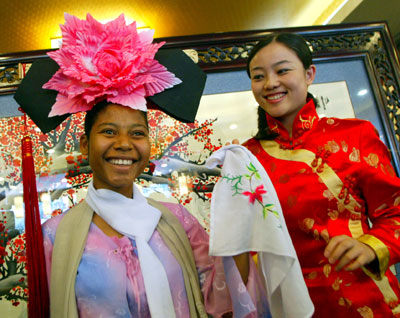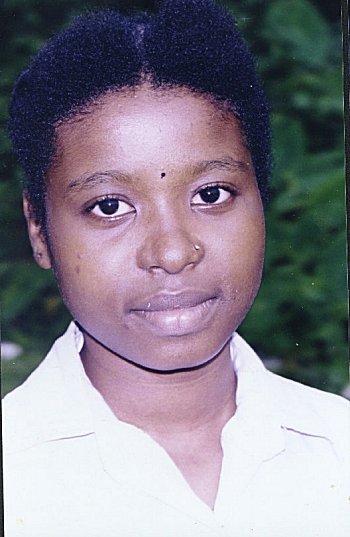Ab-Titchaz
JF-Expert Member
- Jan 30, 2008
- 14,631
- 4,225
600 years of Chinese bloodline in Lamu
By Amos Kareithi
More than 600 years ago, survivors of a Chinese shipwreck found their way to the shores of the Indian Ocean in Kenya. Although historians have varying accounts of these events, there seems to finally be proof that some residents of Shanga Village in Lamu have Chinese blood.
The lonely old man seated at the beach has been reduced to watching birds soar high in the azure blue sky, occasionally diving into the inviting cool waters of the Indian Ocean, teasing the fisherman.
His gaze has been occasionally shifting to the boats berthing at the old dilapidated jetty. When his concentration wanes, he shakes his head wistfully, marvelling at the mysteries of nature.
Looking at the old dhows and the newer fibre boats as they come and leave the shores, Athuman Ali Famao temporary goes into a trance.
Oriental blood
He is transported into time when he too could ride the waves to distant lands just like the birds that come and go as they wish, unconcerned by territorial borders defining states and nations.
Although Famao is 60 years old and boasts of little acquaintance with conventional education, he is a repository of history.
Unlike many Kenyans who cannot trace their ancestry, Famao has a hint of where his ancestors came from 600 years ago.
Although he does not have yellow skin and squinted eyes, he has traces of oriental blood, which he attributes to an accident that occurred six centuries ago.
At around 1413, a Chinese navigator, Zheng He, of the Ming Dynasty (1368 to 1644) was on a journey with seven merchant ships on his way to the western part of Indian Ocean.
His fleet launched its voyages from Taicang City in East China's Jiangsu Province.
Idiolised Giraffe
Historians contend this was not the first such trip by a Chinese as historical records show that on a number of occasions, sailors from China had been on the same route during which they showered those they encountered with gifts.
The gifts, which included gold, porcelain and silk, are believed to have originated from the Chinese emperor. In return, the sailors took home ivory, myrrh, zebras and camels.
One of the most spectacular gifts Zheng took from Malindi was a giraffe, which was subjected to a six-months trip in 1417 to China and was ultimately presented to the king.
This story is validated by Esmond Bradely Martin in his book, Malindi, Past and Present, where he recounts how the giraffe won admiration and was at one time idolised as a god.
Martin retells the story of how the giraffe left Malindi in 1415, aboard one of the largest Chinese junks ever, to be subjected to a six-month journey and ceremoniously presented to the Ming Emperor, Yung Lo.
The giraffe, Martin writes, had been secured by Cheng Ho, a eunuch sailor who commanded a fleet of ship plying between Java, Ceylon, India and Hormuz when he happened to pass by Malindi during his fifth trip between 1417 and 1419.
However, it had to be repatriated to Kenya after a short stint owing to its inability to cope with severe climatic conditions.
Other accounts indicate that from 1405, Zheng made a total of seven journeys to South-East Asia, India, the Middle East and Africa, in fleets of up to 300 huge ships with nearly 30,000 sailors.
Shipwreck
There are contradicting accounts about the giraffe gift with some theorising that the animal had been given out by the Sultan of Malindi, on Kenya's northern coast while others suggest that it was taken from the ruler of Bengal in India.
Controversies aside, the presence of giraffes is said to have somehow inspired Zheng to visit Kenya although historians seem to disagree on what came first, the giraffe or Zheng.
Although the passage of time has obliterated most of the details, there are no doubts that during one of his trips to East Africa, which some believe to have been in 1418, the unthinkable happened.
During this particular voyage, one of the ships, capsized in Shanga, Lamu and as fate would have it, the number of fatalities was quite high.
Afro-Chino race
According to reports by The Guardian, the sunken ship is believed to have been part of a mighty armada commanded by Zheng who reached Malindi in 1418.
A handful of sailors are also said to have survived the shipwreck and waded to the shore. There are myths to the effect that they had to prove their worth to the locals by killing a python before they could be accommodated in the village.
Only then were they allowed to marry the local beauties. The blossoming love marked the beginning of a new Afro-Chino race, which has survived six centuries.
Some experts from China have conducted some DNA tests on some of the residents in order to determine whether the residents of Shanga had Chinese blood.
Although Famao's claims, which are based on local folklore, may sound farfetched to a casual listener, the DNA tests seem to have validated them.
After these results, Shanga Village was electrified in 2005, when one of the local girls was proved to have Chinese genetics.
The results proved that the family of Baraka Badishee, whose descendants have distinct Asian features such as yellow skin and almond eyes, had some Chinese blood.
DNA tests
After the DNA tests, Mwanamaka Sharifa was granted a scholarship by the government of China to study traditional medicine, she has since completed her studies.
The government of China and the National Museums of Kenya have also embarked on a Sh200 million project to look for the sank ship.They hope it will produce the ultimate proof and solve the mystery of the Shanga Chinese village.
A group of Chinese and Kenyan underwater archaeologists hope that they will pinpoint the exact place the ship sank, off Pate Island. Their mission is to locate the shipwreck and try to re-float it in the hope that it will offer the missing link of what happened 600 years ago.
But even after all this is done, archaeologists and genetic experts have a tough assignment reconciling how the Chinese genes have for six hundred years survived racial intermarriage.
However, as experts try to figure out what happened to Zheng's ship, the residents of Shanga continue doing what their ancestors have always done.
Despite the strides made in technology, especially in marine, with dhows being replaced by motorised boats and ships, the Indian Ocean, which claimed Zheng's ship, is still as unpredictable as ever.
Famao recalls with nostalgia the 1980s when Somalia had a stable government and seafaring was unhindered by pirates. The Kenya Somalia border was open then.
He says: "I was getting Sh12,000 transporting lobsters, sugar and cooking flour. This is a job I had done for more than five years. Then I would travel to Tanzania, Unguja, Somalia in a sail boat as a captain."
Anarchy reigned
But all this stopped when he was involved in an accident after a rope broke as he was adjusting the sails. So strong was the impact that the backlash broke his hipbone.
"This is why I quit working as a boat captain as I was permanently maimed. Now I have resorted to fishing, which is relatively safer," Famao recalls.
When the tide changed in Somalia and anarchy reigned, Famao was among the first victims who fell into the hands of the pirates.
He explains: "I was once captured in Ndowa 1993 after my boat was hijacked. I was detained for 18 days and only released after paying the pirates about Sh100,000."
Later, Famao used his boat to transport scores of Somali refugees who were fleeing the mayhem in their country after the fall of Siad Barre.
Untameable waters
The disintegration of Somali into a state of lawlessness has affected Famao and many residents of Shanga as they cannot interact with their relatives.
"My grandfather was born in Shungwaya in Somali. One of my young wives, Mameini Mahadhi Ali is a Bajuni who was born in Somalia. Now I cannot visit my in-laws or some of my brothers who are in that country," he adds.
Despite the turbulence caused by the untameable waters of the Indian Ocean, life goes on for the descendants of the shipwrecked Chinese sailors washed ashore 600 years ago by the same waters.
Fumao no longer ventures into these waters even though a larger number of Chinese have been frequenting the area to recover their lost ship.
Some Chinese are also involved in the creation of a larger port in Lamu and this may result in more descendants arising from the renewed visit whose echoes will continue being heard in 2613.
Standard Digital News - Kenya : 600 years of Chinese bloodline in Lamu
By Amos Kareithi
More than 600 years ago, survivors of a Chinese shipwreck found their way to the shores of the Indian Ocean in Kenya. Although historians have varying accounts of these events, there seems to finally be proof that some residents of Shanga Village in Lamu have Chinese blood.
The lonely old man seated at the beach has been reduced to watching birds soar high in the azure blue sky, occasionally diving into the inviting cool waters of the Indian Ocean, teasing the fisherman.
His gaze has been occasionally shifting to the boats berthing at the old dilapidated jetty. When his concentration wanes, he shakes his head wistfully, marvelling at the mysteries of nature.
Looking at the old dhows and the newer fibre boats as they come and leave the shores, Athuman Ali Famao temporary goes into a trance.
Oriental blood
He is transported into time when he too could ride the waves to distant lands just like the birds that come and go as they wish, unconcerned by territorial borders defining states and nations.
Although Famao is 60 years old and boasts of little acquaintance with conventional education, he is a repository of history.
Unlike many Kenyans who cannot trace their ancestry, Famao has a hint of where his ancestors came from 600 years ago.
Although he does not have yellow skin and squinted eyes, he has traces of oriental blood, which he attributes to an accident that occurred six centuries ago.
At around 1413, a Chinese navigator, Zheng He, of the Ming Dynasty (1368 to 1644) was on a journey with seven merchant ships on his way to the western part of Indian Ocean.
His fleet launched its voyages from Taicang City in East China's Jiangsu Province.
Idiolised Giraffe
Historians contend this was not the first such trip by a Chinese as historical records show that on a number of occasions, sailors from China had been on the same route during which they showered those they encountered with gifts.
The gifts, which included gold, porcelain and silk, are believed to have originated from the Chinese emperor. In return, the sailors took home ivory, myrrh, zebras and camels.
One of the most spectacular gifts Zheng took from Malindi was a giraffe, which was subjected to a six-months trip in 1417 to China and was ultimately presented to the king.
This story is validated by Esmond Bradely Martin in his book, Malindi, Past and Present, where he recounts how the giraffe won admiration and was at one time idolised as a god.
Martin retells the story of how the giraffe left Malindi in 1415, aboard one of the largest Chinese junks ever, to be subjected to a six-month journey and ceremoniously presented to the Ming Emperor, Yung Lo.
The giraffe, Martin writes, had been secured by Cheng Ho, a eunuch sailor who commanded a fleet of ship plying between Java, Ceylon, India and Hormuz when he happened to pass by Malindi during his fifth trip between 1417 and 1419.
However, it had to be repatriated to Kenya after a short stint owing to its inability to cope with severe climatic conditions.
Other accounts indicate that from 1405, Zheng made a total of seven journeys to South-East Asia, India, the Middle East and Africa, in fleets of up to 300 huge ships with nearly 30,000 sailors.
Shipwreck
There are contradicting accounts about the giraffe gift with some theorising that the animal had been given out by the Sultan of Malindi, on Kenya's northern coast while others suggest that it was taken from the ruler of Bengal in India.
Controversies aside, the presence of giraffes is said to have somehow inspired Zheng to visit Kenya although historians seem to disagree on what came first, the giraffe or Zheng.
Although the passage of time has obliterated most of the details, there are no doubts that during one of his trips to East Africa, which some believe to have been in 1418, the unthinkable happened.
During this particular voyage, one of the ships, capsized in Shanga, Lamu and as fate would have it, the number of fatalities was quite high.
Afro-Chino race
According to reports by The Guardian, the sunken ship is believed to have been part of a mighty armada commanded by Zheng who reached Malindi in 1418.
A handful of sailors are also said to have survived the shipwreck and waded to the shore. There are myths to the effect that they had to prove their worth to the locals by killing a python before they could be accommodated in the village.
Only then were they allowed to marry the local beauties. The blossoming love marked the beginning of a new Afro-Chino race, which has survived six centuries.
Some experts from China have conducted some DNA tests on some of the residents in order to determine whether the residents of Shanga had Chinese blood.
Although Famao's claims, which are based on local folklore, may sound farfetched to a casual listener, the DNA tests seem to have validated them.
After these results, Shanga Village was electrified in 2005, when one of the local girls was proved to have Chinese genetics.
The results proved that the family of Baraka Badishee, whose descendants have distinct Asian features such as yellow skin and almond eyes, had some Chinese blood.
DNA tests
After the DNA tests, Mwanamaka Sharifa was granted a scholarship by the government of China to study traditional medicine, she has since completed her studies.
The government of China and the National Museums of Kenya have also embarked on a Sh200 million project to look for the sank ship.They hope it will produce the ultimate proof and solve the mystery of the Shanga Chinese village.
A group of Chinese and Kenyan underwater archaeologists hope that they will pinpoint the exact place the ship sank, off Pate Island. Their mission is to locate the shipwreck and try to re-float it in the hope that it will offer the missing link of what happened 600 years ago.
But even after all this is done, archaeologists and genetic experts have a tough assignment reconciling how the Chinese genes have for six hundred years survived racial intermarriage.
However, as experts try to figure out what happened to Zheng's ship, the residents of Shanga continue doing what their ancestors have always done.
Despite the strides made in technology, especially in marine, with dhows being replaced by motorised boats and ships, the Indian Ocean, which claimed Zheng's ship, is still as unpredictable as ever.
Famao recalls with nostalgia the 1980s when Somalia had a stable government and seafaring was unhindered by pirates. The Kenya Somalia border was open then.
He says: "I was getting Sh12,000 transporting lobsters, sugar and cooking flour. This is a job I had done for more than five years. Then I would travel to Tanzania, Unguja, Somalia in a sail boat as a captain."
Anarchy reigned
But all this stopped when he was involved in an accident after a rope broke as he was adjusting the sails. So strong was the impact that the backlash broke his hipbone.
"This is why I quit working as a boat captain as I was permanently maimed. Now I have resorted to fishing, which is relatively safer," Famao recalls.
When the tide changed in Somalia and anarchy reigned, Famao was among the first victims who fell into the hands of the pirates.
He explains: "I was once captured in Ndowa 1993 after my boat was hijacked. I was detained for 18 days and only released after paying the pirates about Sh100,000."
Later, Famao used his boat to transport scores of Somali refugees who were fleeing the mayhem in their country after the fall of Siad Barre.
Untameable waters
The disintegration of Somali into a state of lawlessness has affected Famao and many residents of Shanga as they cannot interact with their relatives.
"My grandfather was born in Shungwaya in Somali. One of my young wives, Mameini Mahadhi Ali is a Bajuni who was born in Somalia. Now I cannot visit my in-laws or some of my brothers who are in that country," he adds.
Despite the turbulence caused by the untameable waters of the Indian Ocean, life goes on for the descendants of the shipwrecked Chinese sailors washed ashore 600 years ago by the same waters.
Fumao no longer ventures into these waters even though a larger number of Chinese have been frequenting the area to recover their lost ship.
Some Chinese are also involved in the creation of a larger port in Lamu and this may result in more descendants arising from the renewed visit whose echoes will continue being heard in 2613.
Standard Digital News - Kenya : 600 years of Chinese bloodline in Lamu


